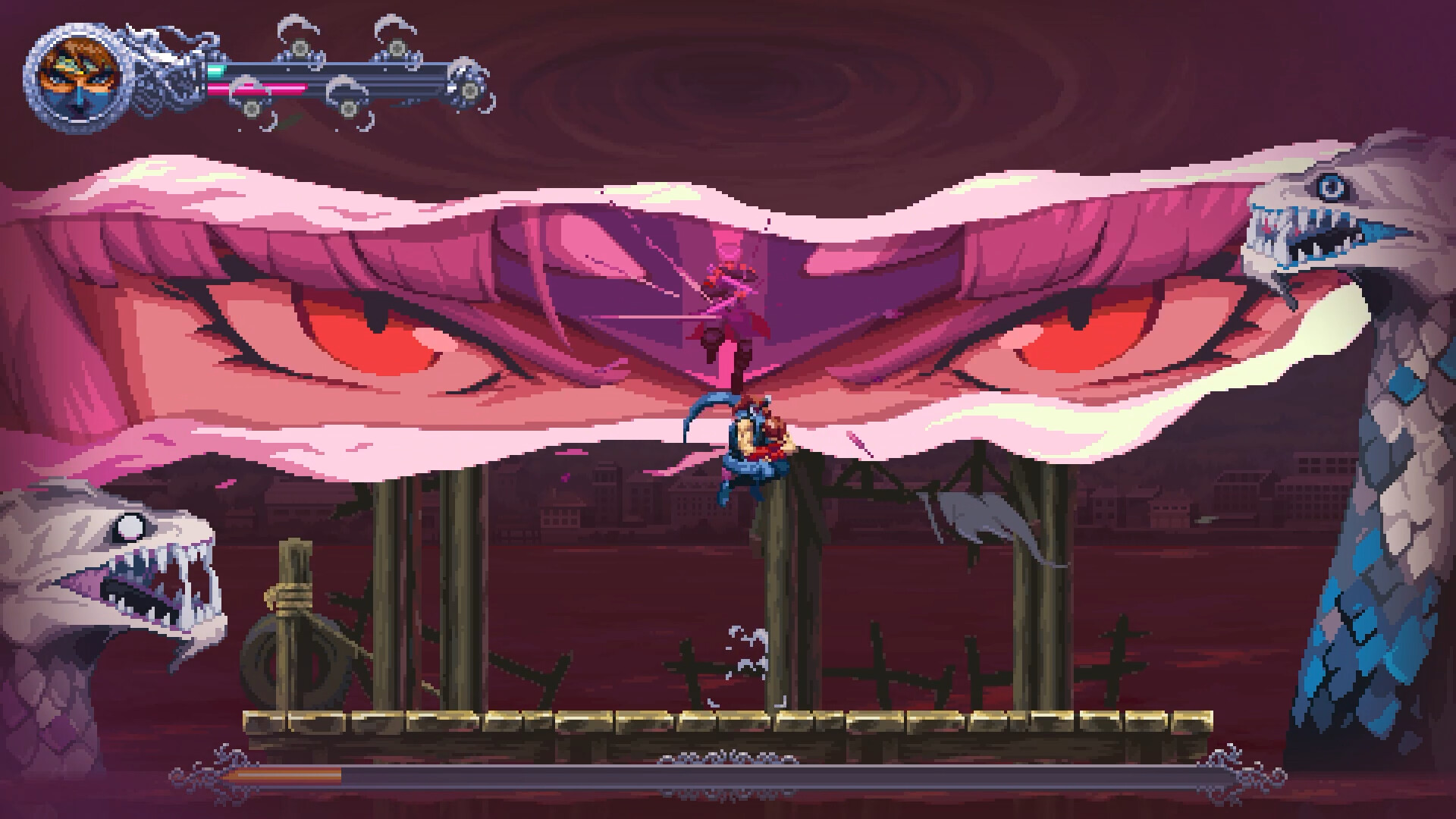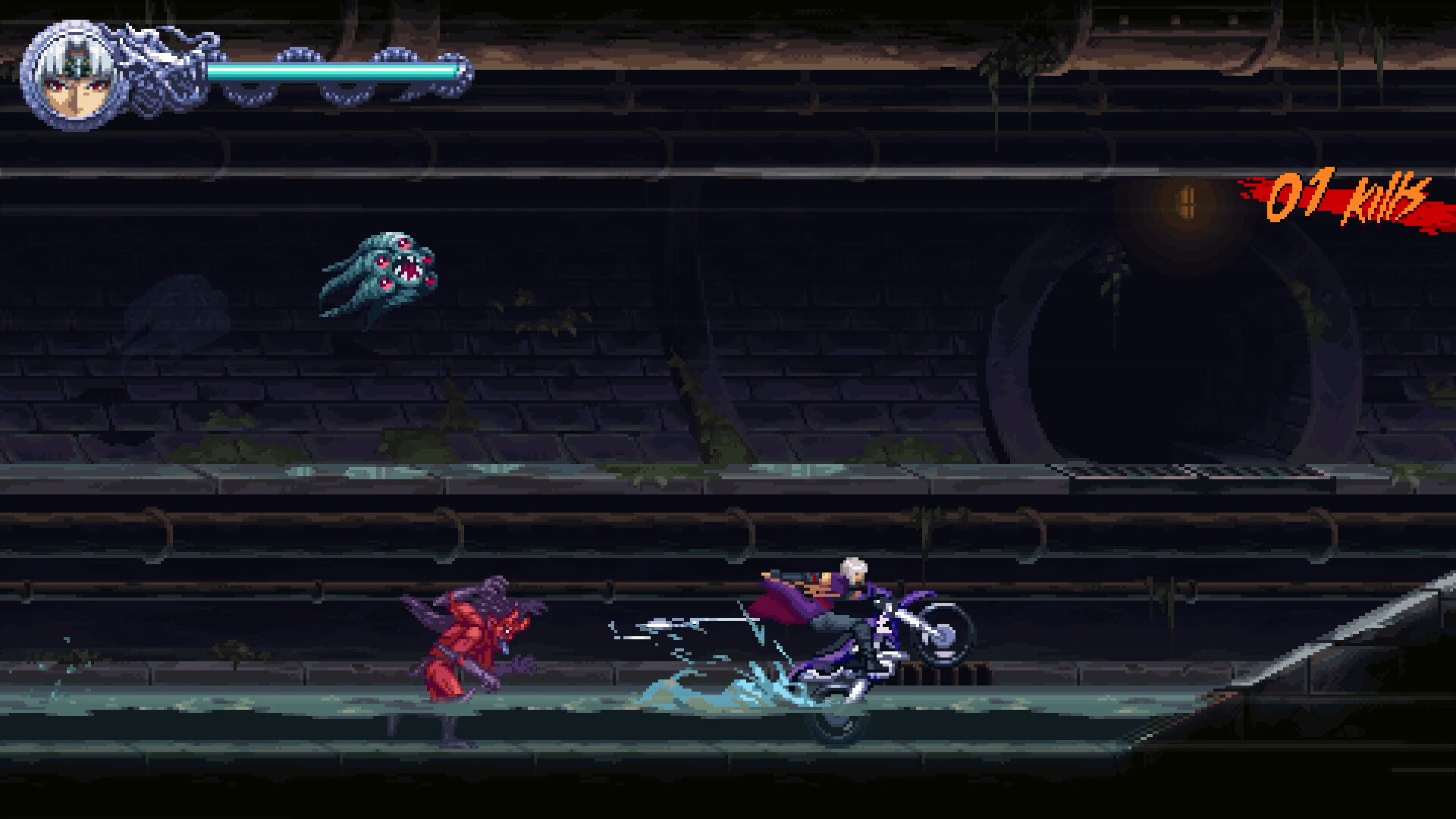Ninja Gaiden: Ragebound Review – Master Ninja Tier
As gruesomely epic as the 3D Ninja Gaidens have been (and the upcoming Ninja Gaiden 4 looks to be the very best when it launches in October), there’s a place for the 2D side-scrolling games of yore. Relegated to the good old days of the NES, Ninja Gaiden was as brutally difficult as they come while receiving extensive acclaim for its action and presentation. While Ninja Gaiden: Ragebound isn’t purporting to offer that same level of challenge, it is a fast-paced action side-scroller where precision platforming can be just as important as systematically tearing apart enemies. And it’s pretty darn fun in the process.
In a twist from previous games, 2D and 3D, you don’t control Ryu Hayabusa. Instead, Kenji Mozu, a young upstart, is the star. After an attack on Hayabusa and hearing their plans to resurrect the Demon Lord, Kenji sets out to stop them, venturing into the hornet’s nest with little caution. Parallel to all of this is Kumori of the Black Spider Clan, whose headquarters were ambushed by the same demons during a meeting between the higher-ups. She’s also sent out to meet the demons but to forcefully broker a deal and capture the Demon Lord using the Tamashi Kunai.
Naturally, things go terribly for both of them, and the two mortal enemies are forced to fuse their souls to survive. It should be noted throughout all of this that Ninja Gaiden: Ragebound offers some surprisingly good writing and pacing to carry the plot (for this genre, at least). Both Kenji and Kumori straddle a fine line between confidence and arrogance, which is reflected well in their dialogue.
[embedded content]
“Of course, this can become a more challenging endeavor when juggling two different Hypercharged states. Due to their predicament, players essentially run around as Kenji, hacking and slashing foes with a blade as per usual, but can also utilize Kumori’s abilities with enough Ki.”
I wouldn’t have expected to praise a Ninja Gaiden title for its narrative or characterization, but I took a liking to both protagonists pretty much immediately. Despite the relatively straightforward nature of the story, the inherent tension between them makes for some fun banter (and a bit of mystery on how their situation could be resolved). There is a bit of ridiculousness involved, like random run-ins with the military, but it’s nothing out of the ordinary for Ninja Gaiden.
Of course, at its core, Ragebound is a challenging side-scrolling hack-and-slash platformer. You’re still running through some gorgeous retro-style environments, slaying enemies, and usually facing off against a boss before progressing to the next stage. Both characters possess some sleek mobility options, including the ability to kick off enemies and projectiles using the Guillotine Boost, dealing a bit of damage but mostly extending their air time (which can be useful for crossing perilous gaps).
The other core mechanic is the Hypercharged Strike. By defeating certain foes or sacrificing a portion of their health, Kenji and Kumori can unleash powerful melee or ranged attacks. These are essential for defeating tankier enemies with a single slice and maintaining momentum. However, there’s a bit of resource management and guesswork involved. Will you wait for a specific enemy to show up and die so you can enter the Hypercharged state, or sacrifice some health to push forward? The fact that Hypercharged Strikes can stagger bosses, opening them for a hefty helping of slashes and kunai (and thus shortening the overall length of the fight), lends an extra layer of strategy.
Of course, this can become a more challenging endeavor when juggling two different Hypercharged states. Due to their predicament, players essentially run around as Kenji, hacking and slashing foes with a blade as per usual, but can also utilize Kumori’s abilities with enough Ki. These include Kama, which passes through walls to defeat enemies and kunai, which you can aim in any direction. Defeat a red charged enemy to Hypercharge the Spider Weapons or a melee strike to Hypercharge Kenji’s attacks.
“Any seasoned action platformer player won’t find too much difficulty with Ragebound. Which isn’t to say it’s not worth your time. Once you’re in the groove, seamlessly platforming and annihilating enemies before they even know what’s happening, it’s incredibly fun.”
You would think this could dull the overall pacing, but once you learn enemy placement and spawns, it becomes as second nature as platforming and slashing. Of course, there are specific sections in levels where you’ll directly control Kumori, venturing through an alternate dimension to open the way forward. These sections are on a timer, and though there are items to help extend this, it can be a bit of trial and error to find the right path and properly platform through, almost like a microcosm of the levels at large.
Despite the relative “newness” of all this compared to the old-school Ninja Gaiden, it’s still in keeping with the series’ punishing gameplay, especially since a single drop into deadly terrain means a return trip to the nearest checkpoint. Once you have a rhythm for a level’s layout and enemies, however, the overall difficulty doesn’t feel nearly as oppressive.
The presence of Talismans, which provide game-changing effects like slight healthy recovery upon slaying enemies above a certain combo score, certainly helps in that regard. But even the boss fights didn’t require too many retries. I also found some level design elements to be a little repetitive at times, especially when it came to platforming. The Game Kitchen does a decent job of mixing things up, throwing in a sudden ambush of enemies or a boss chasing you while destroying the flooring. However, despite completely different locations, that feeling of platforming deja vu would crop up more than not. The side areas also couldn’t use a bit more work to make them shine beyond pursuing collectibles.
On top of clearing a level, there are optional challenges available, like not getting hit or slaying a certain number of enemies with Guillotine Boosts, to incentivize perfection (not to mention collecting Crystal Skulls and Golden Scarabs). But any seasoned action platformer player won’t find too much difficulty with Ragebound. Which isn’t to say it’s not worth your time. Once you’re in the groove, seamlessly platforming and annihilating enemies before they even know what’s happening, it’s incredibly fun.
“The sprite work for both characters and environments looks great, and the animations of enemies, bosses, and the protagonists flow extremely well, and even the scenes between levels look extremely sharp.”
Significant praise must be given to the controls, which feel seamlessly responsive. I didn’t face a single point where my actions didn’t feel like my own, though, of course, in that respect, every mistake is completely on me. For those who find the difficulty a little too extreme, some accessibility options are available, like reducing incoming damage and game speed, extending the Hypercharged state, and even increasing the size of the Guillotine Boost to make platforming that much less punishing.
While the visuals won’t necessarily be deemed as the most visually cutting edge, they’re simply gorgeous from a 2D standpoint. The sprite work for both characters and environments looks great, and the animations of enemies, bosses, and the protagonists flow extremely well, and even the scenes between levels look extremely sharp. I also appreciated the little animated highlights when defeating bosses, adding even more panache to the kill. Further enhancing the mood is the music, which captures the 80s vibe of the original games but with much fuller instrumentation. From the main menu to downtime at Muramasa’s shop, each track feels lovingly crafted to pay homage to the classics while remaining catchy in their own right.
Ninja Gaiden: Ragebound won’t necessarily break the mold when it comes to side-scrollers, but it doesn’t have to. It’s a well-made, contemporary tribute to the classics that also channels their gameplay loop to deliver a new story with sleek new mechanics and challenges while providing plenty of optional goals to keep you coming back.
This game was reviewed on PC.




Comments are closed.